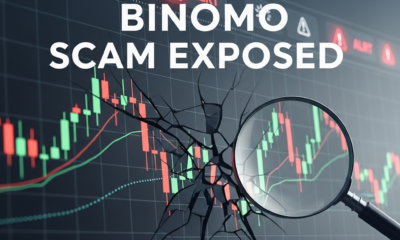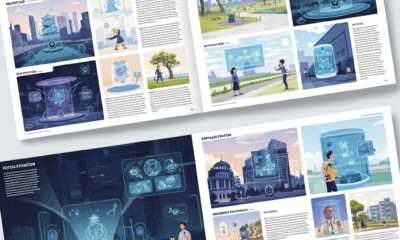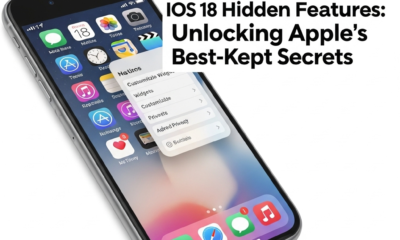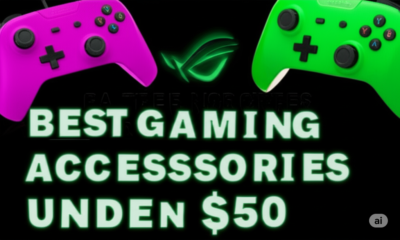General
Discover the 8 Crucial Phases Involved in the 3D Product Modeling Process

3D product modeling has become integral to various industries, ranging from manufacturing and architecture to advertising and gaming. It allows businesses to create realistic virtual representations of their products, enabling them to effectively showcase their designs, test functionalities, and market their offerings.
Various well-reputed 3D animation studios with expertise, technical skills, and cutting-edge software tools are available to create highly realistic and tempting 3D models.
Outsourcing product modeling to a reputable company can save time, resources, and effort while ensuring top-notch quality and accuracy in product representations.
Let’s explore the eight stages of product modeling in the 3D process and shed light on its importance.
1. Conceptualization Stage
The first stage of the 3D product modeling process is conceptualization. Here, the client and the 3D modeling team collaborate to define the product’s requirements, specifications, and design objectives. It involves understanding the purpose, target audience, and desired product features, allowing the team to establish a clear vision for the modeling process.
2. Reference Gathering
The next stage involves gathering references. The 3D modeling team collects relevant images, sketches, technical drawings, and other visual references that aid in understanding the product’s physical appearance and functionality. These references serve as a guide during the modeling process, ensuring accuracy and realism.
3. 3D Modeling Phase
In this stage, skilled artists and modelers use specialized software to create a virtual three-dimensional representation of the product based on the gathered references. It involves shaping the geometry, adding intricate details, and refining the overall appearance to achieve a lifelike representation.
4. Texturing and Materials
After creating the primary 3D models, the next step is to apply textures and materials to make them look more realistic. Texturing involves adding surface details such as colors, patterns, and textures to imitate real-world materials. By accurately replicating the product’s materials, such as metal, plastic, or fabric, the 3D model achieves high visual fidelity.
5. Lighting and Rendering
Proper lighting and rendering techniques bring the 3D model to life. The 3D artists strategically place virtual lights, simulating real-world lighting conditions to create shadows, highlights, and reflections. Rendering generates the final 2D image or animation of the 3D model, incorporating lighting effects, textures, and materials to produce a photorealistic result.
6. Rigging and Animation
Rigging and animation are essential for products requiring dynamic movements or demonstrations. Rigging involves adding a virtual skeleton or structure to the 3D model, enabling it to be animated. Skilled animators bring the product to life by creating lifelike movements and showcasing its functionalities, assembly processes, or user interactions.
7. Iteration and Feedback
Throughout the 3D product modeling process, regular feedback and iteration are crucial. The client reviews the work at various stages, providing feedback and suggestions for improvements. This iterative process ensures that the final 3D model aligns with the client’s vision and meets their expectations.
8. Final Delivery
After incorporating feedback and making necessary revisions, the finalized 3D model is delivered to the client in the desired format. The client can then utilize the model for marketing campaigns, presentations, virtual simulations, or other purposes that effectively communicate the product’s features and benefits.
List of Best Software for 3D Product Modeling
There are various software for 3D product modeling that are up to your project’s specific requirements, expertise level, budget constraints, and personal preferences.
- Autodesk Maya: This software is versatile and widely used in the industry for 3D modeling, animation, rendering, and simulation. It offers powerful modeling, texturing, and animation tools, making it suitable for various projects, including product modeling.
- Blender: It is free and open-source software with a robust set of features for 3D modeling, animation, rendering, and compositing. It has a large community of users and developers, continuously evolving and improving. Blender is an excellent option for those on a budget or looking for an accessible tool for 3D modeling.
- ZBrush: It is renowned for its advanced sculpting capabilities, making it a preferred choice for artists focusing on high-detail sculpting for characters, creatures, and organic shapes. While it’s not typically used for traditional product modeling, it can help create intricate details or complex shapes.
- Cinema 4D: This software is known for its ease of use and intuitive interface, making it popular among motion graphics artists and designers. While it may not be as feature-rich for hardcore modeling as Maya or Blender, it can still handle product modeling tasks, especially if integrated with other software in a pipeline.
- Houdini: It is a powerful software often used for procedural modeling, simulation, and visual effects. It offers a node-based workflow that allows for complex and dynamic creations. While it may have a steeper learning curve than other options, it’s highly versatile and can be used for various 3D projects, including product modeling.
To Conclude
The 3D product modeling process encompasses several stages, from conceptualization to final delivery. Each stage contributes to creating remarkable and functionally accurate virtual product models. Businesses can effectively showcase their products, streamline design processes, and gain a competitive edge in their industries with services provided by professional 3D animation studios. In this advanced century, product modeling opens new avenues for innovation, marketing, and customer engagement
General
UK Visa Fees 2025: Complete Breakdown for Students, Workers & Tourists

📌 Introduction
If you’re planning to visit or move to the UK in 2025, you’ll definitely need to know the latest UK visa fees. Whether you’re a student, a tourist, or applying for a work permit, visa costs vary depending on your category. In this article, we break down UK Visa Fees 2025 for different types of visas, including Pakistani applicants and global travelers. Make sure to check the details for UK Visa Fees 2025 to avoid any surprises.
🧳 1. UK Tourist Visa Fees 2025
| Visa Type | Duration | Fee (GBP) | Fee in PKR (approx.) |
|---|---|---|---|
| Standard Visitor Visa | 6 months | £115 | ~40,000 PKR |
| Long-Term Visitor Visa | 2 years | £400 | ~140,000 PKR |
| Long-Term Visitor Visa | 5 years | £771 | ~270,000 PKR |
💡 Note: Pakistani rupee values vary based on exchange rate (approx. £1 = 350 PKR as of mid-2025)
🎓 2. UK Student Visa Fees 2025
| Visa Type | Fee (GBP) | Fee in PKR |
|---|---|---|
| General Student Visa (Tier 4) | £490 | ~172,000 PKR |
| Short-term Study Visa | £200 | ~70,000 PKR |
🔍 IHS (Immigration Health Surcharge):
-
£776 per year (must be paid along with student visa)
-
Covers NHS healthcare access
🛠 3. UK Work Visa Fees 2025
| Work Visa Type | Fee (GBP) | Fee in PKR |
|---|---|---|
| Skilled Worker Visa (<3 years) | £719 | ~250,000 PKR |
| Skilled Worker Visa (>3 years) | £1,420 | ~497,000 PKR |
| Health & Care Worker Visa | £284 | ~100,000 PKR (discounted) |
📝 Tip: Always check whether the job role is on the UK’s shortage occupation list for reduced fees.
🧑🤝🧑 4. Family Visa Fees
| Visa Type | Fee (GBP) | Fee in PKR |
|---|---|---|
| Spouse/Partner Visa | £1,846 | ~645,000 PKR |
| Child Dependent Visa | £1,846 | ~645,000 PKR |
💰 5. UK Priority & Super Priority Services
-
Priority Visa Service: £500 (~175,000 PKR) – 5 working days
-
Super Priority Visa: £1,000 (~350,000 PKR) – next working day
⚠️ These are optional and only for faster processing.
🌍 6. Visa Application Center Charges (Pakistan)
-
Gerry’s Visa Service Fee: Rs. 6,000 to 10,000
-
SMS Tracking Service: Rs. 500
-
Document Scanning Help (optional): Rs. 2,000+
🛑 7. Common Mistakes to Avoid
-
Submitting expired documents
-
Not paying the correct IHS fee
-
Wrong passport photo size
-
Forgetting to print appointment confirmation
🧠 FAQs About UK Visa Fees 2025
Q: Can I pay the UK visa fee in Pakistani Rupees?
A: No, it must be paid in GBP using debit/credit card.
Q: Are UK visa fees refundable?
A: Only under rare cases if the application is not processed.
Q: Do visa fees change during the year?
A: Yes, fees can change without prior notice — always check the official UK Visa Fee website.
📝 Final Thoughts
UK visa fees in 2025 have increased slightly compared to previous years, especially for work and student visas. It’s important to double-check the latest fees before applying and always keep a buffer budget for service charges and currency conversion.
If you found this guide helpful, please share it or leave a comment below. Bookmark this page for future updates!
General
RTasks Login: Complete Guide to Access Your Account Introduction

Are you looking for a simple way to access your RTasks login portal? RTasks is a popular task management and staff communication platform used in healthcare, senior living, and other industries. In this guide, we’ll walk you through the RTasks login process, troubleshooting tips, and how to reset your password if needed.
How to Access RTasks Login Portal
Follow these steps to log in to your RTasks account:
-
Visit the Official RTasks Login Page
-
Go to the RTasks website (typically
https://rtasks.netor your organization’s custom login URL).
-
-
Enter Your Credentials
-
Username: Input your registered email or username.
-
Password: Type your secure password.
-
-
Click “Login”
-
If credentials are correct, you’ll be directed to your dashboard.
-
-
Troubleshooting Login Issues
-
Forgot Password? Click the “Forgot Password” link to reset it via email.
-
Account Locked? Contact your administrator for assistance.
-
Page Not Loading? Clear browser cache or try a different browser.
-
Why Can’t I Log In to RTasks? (Common Issues & Fixes)
If you’re facing RTasks login problems, here are some solutions:
✅ Incorrect Password → Use the password reset option.
✅ Browser Compatibility → Try Chrome, Firefox, or Edge.
✅ Network Issues → Check your internet connection.
✅ Server Down → Visit RTasks status page or contact support.
How to Reset Your RTasks Password
If you forgot your password:
-
Click “Forgot Password” on the login page.
-
Enter your registered email address.
-
Check your inbox for a password reset link.
-
Create a new strong password and log in again.
RTasks Mobile App Login
You can also access RTasks on your smartphone:
📱 Download the RTasks app (iOS/Android).
🔑 Use the same login credentials as the web version.
🔄 Sync tasks & updates in real-time.
Final Thoughts
The RTasks login process is quick and easy if you have the right credentials. Bookmark the login page for faster access, and ensure your password is secure. If issues persist, contact your organization’s admin or RTasks support.
General
Free Procreate Brushes: Elevate Your Digital Art

The rise of digital art has revolutionized how creators express themselves. One of the most popular apps among artists is Procreate, known for its intuitive design and powerful features. However, the real magic lies in the vast selection of free Procreate brushes available to enhance creativity.
In this guide, we explore where to find the best free Procreate brushes, how to use them effectively, and tips to expand your digital toolkit.
Click Here Also.
Why Free Procreate Brushes Are Essential
For artists and designers, having a variety of brushes can:
- Improve workflow
- Add unique textures and styles
- Enhance project quality without extra costs
While Procreate offers a strong set of default brushes, free custom brushes help unlock unlimited possibilities, catering to specific styles like watercolor, inking, calligraphy, and textured painting.
Top Sources for Free Procreate Brushes
Here are some reliable platforms where you can download high-quality free Procreate brushes:
1. Procreate Official Website
Procreate’s own community forum often features free brushes shared by artists.
2. Gumroad
Many creators list free brush sets on Gumroad. Simply search “free Procreate brushes,” and you will find thousands of options.
3. Creative Market
Creative Market occasionally offers free brushes as part of their weekly free goods. Check regularly to grab limited-time offerings.
4. DeviantArt
DeviantArt has a rich community of digital artists who often share free brush packs.
5. Reddit (r/Procreate)
Reddit communities like r/Procreate are excellent for discovering hidden gems shared by fellow artists.
How to Install Free Procreate Brushes
Installing Procreate brushes is simple:
- Download the .brush or .brushset file.
- Open Procreate and tap the brush icon.
- Choose “Import” and select the downloaded file.
- The brush will now appear in your library, ready for use.
Always ensure you are downloading from reputable sources to avoid corrupted files or malware.
Best Free Procreate Brushes Categories
Depending on your project, different brush types may be needed. Here are some categories to consider:
Watercolor Brushes
Mimic the soft blending and bleeding effects of traditional watercolor painting.
Inking Brushes
Perfect for comic book artists or illustrators who need clean, sharp lines.
Calligraphy Brushes
Ideal for hand lettering projects and typography enthusiasts.
Texture Brushes
Add depth and realism to your artwork with subtle textures.
Special Effects Brushes
Create glowing lights, sparkles, smoke, and other visual effects effortlessly.
Tips for Using Free Procreate Brushes Effectively
- Experiment: Try different brushes in one piece to find unique combinations.
- Organize: Group your brushes into folders by style or project type for easy access.
- Customize: Adjust brush settings like opacity, flow, and jitter to better suit your needs.
- Stay Updated: Artists frequently update their brush sets. Keep an eye on your favorite creators.
Frequently Asked Questions (FAQs)
Q: Are free Procreate brushes safe to download? A: Yes, as long as you download from reputable sites like Procreate forums, Gumroad, or Creative Market.
Q: Can I use free brushes for commercial projects? A: Always check the license terms provided by the creator. Most free brushes are fine for personal use; some are cleared for commercial projects.
Q: How do I make my own Procreate brush? A: Procreate offers a “Brush Studio” where you can create fully customized brushes by adjusting shape, grain, and behavior settings.
Conclusion: Unlock Your Creativity
Utilizing free Procreate brushes is one of the best ways to enhance your digital art without additional expenses. From beginners to seasoned professionals, these resources offer a wide range of styles and functionalities.
Explore, experiment, and express yourself more vividly by integrating high-quality free brushes into your workflow. Your next masterpiece is just a brushstroke away.
-

 news2 days ago
news2 days agoBinomo Scam Exposed: Real Truth Behind the Trading App You Must Know in 2025
-
Business3 weeks ago
Why Bulk Custom Playing Cards Are the Secret Weapon for Brand Visibility and Creative Projects
-
Tech3 weeks ago
Revolutionizing Marketing with AI: How Visionation Helps Brands Dominate Google Rankings
-

 news1 week ago
news1 week agoJames Webb Telescope News: Exploring the Frontiers of the Universe
-

 Tech2 days ago
Tech2 days agoWhat is Janitor AI? Features, Use Cases & How to Use It Safely in 2025
-

 Tech4 days ago
Tech4 days agoPortalar (PortalAR) Guide 2025: How AR Portals Transform Environments
-

 Tech1 week ago
Tech1 week agoiOS 18 Hidden Features: Unlocking Apple’s Best-Kept Secrets
-

 Gaming4 days ago
Gaming4 days agoBest Gaming Accessories Under $50 in 2025 – Ultimate Budget Gaming Upgrades





